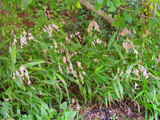Native Plants

Q. Who is Mr. Smarty Plants?
A: There are those who suspect Wildflower Center volunteers are the culpable and capable culprits. Yet, others think staff members play some, albeit small, role. You can torture us with your plant questions, but we will never reveal the Green Guru's secret identity.
Did you know you can access the Native Plant Information Network with your web-enabled smartphone?
Ask Mr. Smarty Plants is a free service provided by the staff and volunteers at the Lady Bird Johnson Wildflower Center.

rate this answer
Wednesday - July 01, 2009
From: Merrill, IA
Region: Midwest
Topic: Seeds and Seeding, Erosion Control, Grasses or Grass-like
Title: Plants for steep embankment on the Missouri River in Nebraska
Answered by: Nan Hampton
QUESTION:
Hi, My embankment along the Northeast Nebraska shoreline of the Missouri River is eroding the land away. Do you have any suggestions for seed I could throw over the side of the bank that would grow and perhaps slow the erosion or stop it? It is too steep to walk on. Thanks.ANSWER:
We recommend grasses for controlling erosion because of their extensive fibrous root systems that serve to hold the soil in place. However, I don't think just throwing grass seeds over the side of your bank is going to work very well. The seeds need moisture to germinate. If the moisture comes in the form of rain, it is likely to wash the seeds down the bank into the river before that have a chance to germinate and take root. There are two possible solutions—an erosion control blanket or pneumatic compost/seed application. The erosion-control fabric works by slowing the runoff water and allowing sediments to fall out rather than be washed away. Seeds are sown under the erosion-control material and grow up through the matting when they germinate. You can also insert plants into the soil by cutting through the matting. The roots of the plants that are growing through the erosion-control material anchor the soil to stop the erosion. If you use erosion-control blankets made of biodegrable material, they will eventually disappear leaving the plants to control the problem. Many nurseries carry this erosion control fabric.
The compost/seed application may be a bit more complicated and expensive than you had in mind since it does require a pneumatic blower, or some mechanical means, to spread the compost/seed mix. The US Composting Council offers information about suppliers of compost and compost technology, but I don't really know if this could be a do-it-yourself project. You might check with a landscaping or environmental consulting company in your area who might have the machinery to do this to learn about the feasability and expense of applying the compost/seed mixture this way. You can find the names of Landscape Professionals and Environmental Consultants in your area that specialize in native plants by searching in our National Suppliers Directory.
Here are some grasses that should work on your bank. However, since I don't know the specifics of how much sun/shade or the exact soil type you have there, you will need to compare those aspects of your site with the GROWING CONDITIONS given for each grass.
Andropogon virginicus (broomsedge bluestem)
Aristida purpurea (purple threeawn) is good for erosion control on banks.
Chasmanthium latifolium (Inland sea oats)
Muhlenbergia schreberi (nimblewill)
Panicum virgatum (switchgrass) grows on moist bluffs and stream banks.
Sorghastrum nutans (Indiangrass)
Tripsacum dactyloides (eastern gamagrass)
You can find more grasses to consider by doing a COMBINATION SEARCH in our Native Plant Database and choosing 'Iowa' from the Select State or Province category and 'Grass/Grass-like' from the Habit (general appearance) category. You can also make choices from the Light requirement and Soil moisture categories.
More Grasses or Grass-like Questions
Plants for a drainage easement in central Texas
September 29, 2008 - I have a 1/3 acre of drainage easement behind my home. I would like to cover it with wildflowers. It is only wet during or shortly after a rain and otherwise does not have water. I have channelled ...
view the full question and answer
Plants for slopes in South Texas
October 05, 2009 - Can you provide a list of plants for use on slopes in S. Texas?
view the full question and answer
Evergreen perennials for a pond bank in Texas
June 18, 2015 - We want evergreen perennial plants for the banks of our small pond. The banks are eroding and we need to help keep them strong. We have ducks in the pond and lots of turtles. We would love something ...
view the full question and answer
Problems with Mexican feathergrass
October 24, 2015 - I live in Austin. I've recently seen negative comments re: Mexican feathergrass. Is it native to this area? Is it becoming a problem? I have had it in my yard for years and never considered it a ...
view the full question and answer
Grass for miniature horses
October 31, 2008 - We are looking for buffalo grass or a grass that can be eaten by miniature horses. We have a small non-profit in south Austin and bring the minis home on weekends x2 a month. Our yard has been dirt w...
view the full question and answer
| Support the Wildflower Center by Donating Online or Becoming a Member today. |

